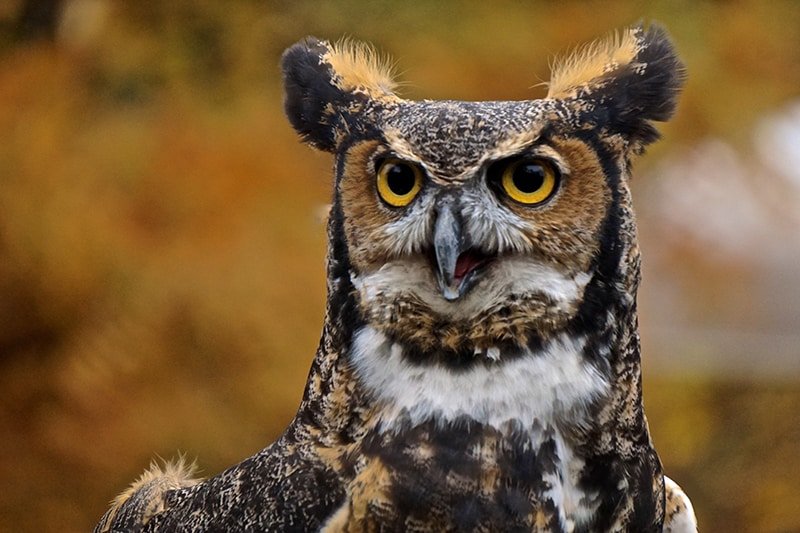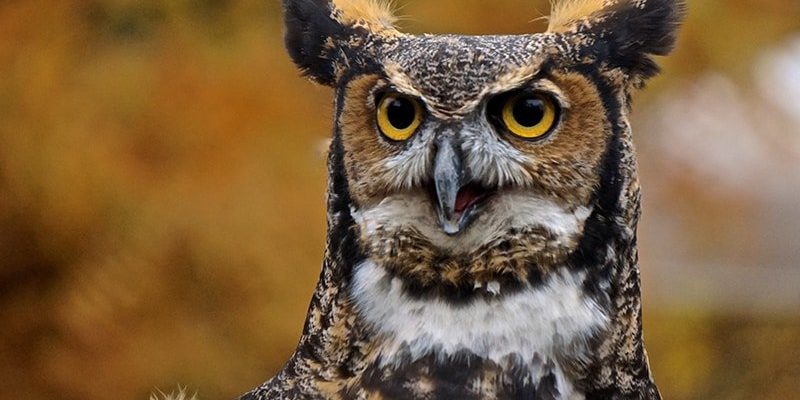
These owls can be found all across North America, from dense forests to suburban areas, making them quite the adaptable creatures. They play a crucial role in their ecosystems and have several unique behaviors that set them apart from other birds. So grab a cup of coffee, and let’s unravel the mysteries of the Great Horned Owl together!
1. Distinctive Appearance and Size
When you first lay eyes on a Great Horned Owl, their size is what grabs your attention. They are one of the largest owls in North America, boasting a wingspan of up to 5.5 feet. That’s as wide as a small car! These owls weigh between 2 to 5.5 kilograms, depending on their habitat and diet. Their feathers are a beautiful mottled brown, which helps them blend into their surroundings—perfect for a predator that relies on stealth.
Their most notable features are those tufted “horns” on their heads. You might picture them as little ears, but they’re actually just feathers that help with communication. The Great Horned Owl can puff them up to appear larger and more intimidating, especially during mating season or when defending their territory. Honestly, it’s hard not to be struck by how majestic they look perched atop a tree branch, surveying their territory.
2. A Wide Range of Habitats
The adaptability of the Great Horned Owl is no small feat. You’ll find them in various environments, from urban parks to remote forests. They thrive in almost any habitat where they can find food and nesting sites. This versatility makes them one of the most widely distributed owls in the Americas. They nest in trees, abandoned structures, or sometimes even on the ground if the conditions are right.
This adaptability can lead to some interesting interactions with humans. For instance, many people have reported sightings of these majestic owls in their neighborhoods. Can you imagine peeking out your window and spotting a Great Horned Owl perched nearby? It’s like having your own nocturnal guardian right in your backyard!
3. Impressive Hunting Skills
If there’s one thing the Great Horned Owl is known for, it’s its exceptional hunting prowess. With powerful talons and sharp beaks, they hunt a variety of prey, from small mammals like rabbits and squirrels to birds and reptiles. Their hunting strategy often includes a stealthy approach, using their remarkable camouflage to blend in with their surroundings.
What’s even more impressive is their ability to hunt in total darkness. They have excellent night vision, allowing them to spot their prey from quite a distance. Their ears are also asymmetrically placed, which helps them pinpoint sounds with incredible accuracy. Imagine being able to hear a mouse scurrying through the grass while perched high in a tree—that’s the power of the Great Horned Owl’s hearing!
4. Unique Calls and Communication
The Great Horned Owl is famous for its deep, resonating hoots. Their calls can be heard over a mile away, making them quite the vocal creatures of the night. Each owl has a unique call, which helps them communicate with potential mates and rivals. The classic “hoo-hoo-hoo” sound is often associated with them, echoing through the forests and providing a haunting background to our evenings.
Interestingly, their calls change with the seasons. During mating season, you’ll hear more frequent calls as males and females establish their bond. Great Horned Owls can also communicate through body language, like puffing up their feathers or altering their posture when threatened. It’s like they have their own social language!
5. Strong Parental Care
Once a Great Horned Owl finds a mate, they become incredibly devoted parents. After laying a clutch of 2 to 5 eggs, both parents share the responsibility of incubation. It’s fascinating to see how they take turns keeping the eggs warm and looking after the young once they hatch. Baby owls, called owlets, are born blind and helpless, relying entirely on their parents for protection and food.
As they grow, the parents continue to hunt for them, bringing back food until the owlets are ready to fledge, or leave the nest. Great Horned Owls typically stay together as a family unit for a while, teaching their young how to hunt before they venture out on their own. It’s like a small, dedicated team working together to ensure everyone’s survival.
6. Diet and Feeding Habits
The Great Horned Owl has a diverse diet that reflects its adaptability. They are opportunistic feeders, meaning they’ll eat whatever is available in their habitat. This can include small mammals, birds, insects, and even reptiles. Their powerful beaks allow them to consume prey larger than themselves, which is quite impressive!
One interesting aspect of their feeding habits is how they consume their prey. Instead of chewing, they swallow smaller animals whole. For larger prey, they may tear it apart first. Once digested, they regurgitate the indigestible parts, like bones and fur, in the form of pellets. It’s like nature’s way of cleaning up after a meal!
7. Symbolism and Cultural Significance
The Great Horned Owl has held significant cultural meanings throughout history. Many Native American tribes view the owl as a symbol of wisdom and protection. In some cultures, they’re seen as messengers between the living and the spirit world. The owl’s nocturnal habits and haunting calls have only added to their mystique.
In modern contexts, you might see the Great Horned Owl depicted in various forms of art and literature, representing a range of themes from guardianship to mystery. It’s fascinating how a creature can hold such a strong presence in human culture, isn’t it?
8. Conservation Status and Threats
Currently, the Great Horned Owl is classified as a species of least concern, meaning they are relatively stable in number. However, they still face threats from habitat destruction, climate change, and pollution. The encroachment of urban development can affect their natural habitats and food supplies.
Conservation efforts focus on preserving their habitats and raising awareness about the importance of these majestic birds. By protecting their ecosystems, we can ensure that the Great Horned Owl continues to thrive for generations to come. It’s a reminder that nature’s balance is delicate, and every creature plays a role.
9. Interesting Behaviors
Great Horned Owls have some fascinating behaviors that make them unique. For instance, they often engage in “flying displays,” where they swoop and dive to show off their prowess, especially during courtship. These displays aren’t just for show; they can also serve to deter rivals from entering their territory.
They also tend to be quite territorial. During breeding season, males will hoot from high perches to establish their dominance and warn other owls to stay away. It’s a dramatic ballet of sounds and feathers—an enchanting sight to witness if you’re lucky enough to catch it.
10. How to Spot a Great Horned Owl
If you’re eager to spot a Great Horned Owl in the wild, there are a few tips to keep in mind. Start by looking near wooded areas, parks, or even your neighborhood at dusk or dawn when they’re most active. Listen for their distinctive hoots; if you hear one, there’s a good chance a Great Horned Owl is nearby.
Look for them perched on tall trees or buildings, often in a relaxed, upright position. Their excellent camouflage makes them harder to spot during the day, but if you keep your eyes peeled, you might just catch a glimpse of one. It’s an unforgettable experience to see this majestic bird in its natural habitat!
As we wrap up this exploration of the Great Horned Owl, it’s clear that this incredible bird is more than just a pretty face. From its impressive hunting skills to its vital role in the ecosystem, the Great Horned Owl is a true marvel of nature. Whether you’re an owl enthusiast or just curious about wildlife, taking the time to learn about these fascinating birds can deepen your appreciation for the wonders of the natural world. So, the next time you hear that iconic hoot echoing through the night, you’ll know a bit more about the remarkable creature behind it!

